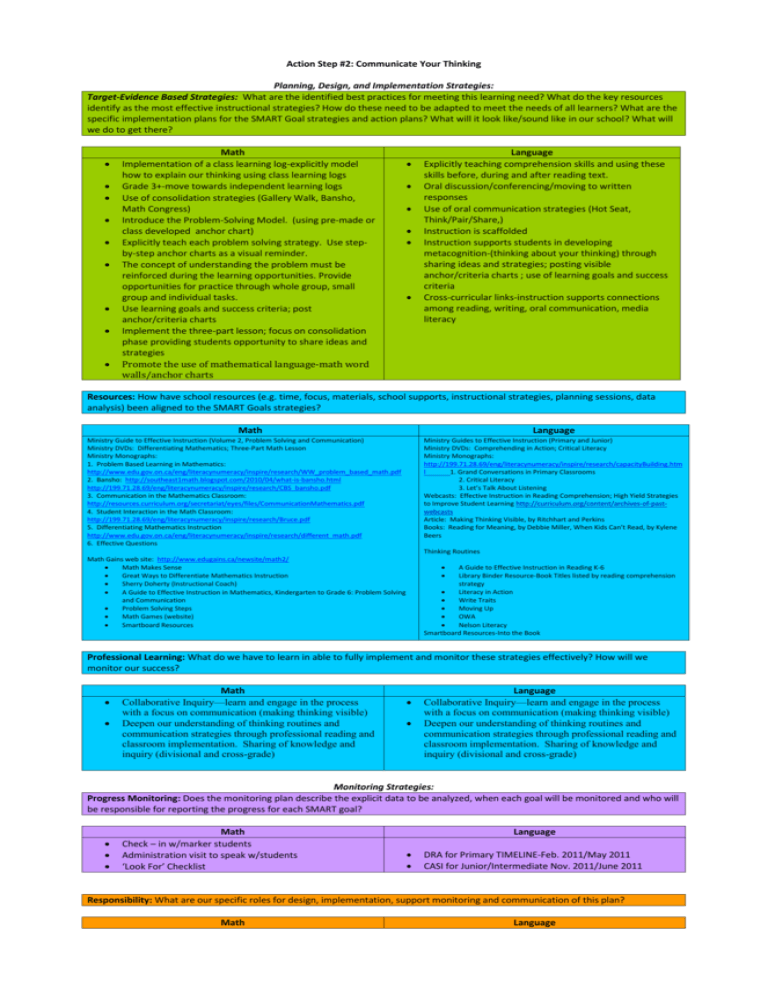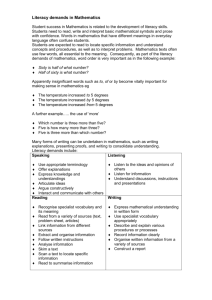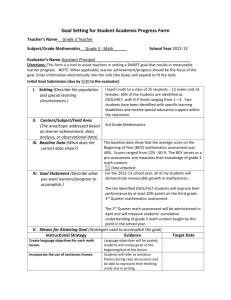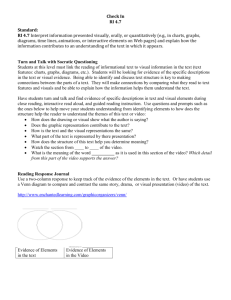PEsipsapg32011-2012
advertisement

Action Step #2: Communicate Your Thinking Planning, Design, and Implementation Strategies: Target-Evidence Based Strategies: What are the identified best practices for meeting this learning need? What do the key resources identify as the most effective instructional strategies? How do these need to be adapted to meet the needs of all learners? What are the specific implementation plans for the SMART Goal strategies and action plans? What will it look like/sound like in our school? What will we do to get there? Math Implementation of a class learning log-explicitly model how to explain our thinking using class learning logs Grade 3+-move towards independent learning logs Use of consolidation strategies (Gallery Walk, Bansho, Math Congress) Introduce the Problem-Solving Model. (using pre-made or class developed anchor chart) Explicitly teach each problem solving strategy. Use stepby-step anchor charts as a visual reminder. The concept of understanding the problem must be reinforced during the learning opportunities. Provide opportunities for practice through whole group, small group and individual tasks. Use learning goals and success criteria; post anchor/criteria charts Implement the three-part lesson; focus on consolidation phase providing students opportunity to share ideas and strategies Promote the use of mathematical language-math word walls/anchor charts Language Explicitly teaching comprehension skills and using these skills before, during and after reading text. Oral discussion/conferencing/moving to written responses Use of oral communication strategies (Hot Seat, Think/Pair/Share,) Instruction is scaffolded Instruction supports students in developing metacognition-(thinking about your thinking) through sharing ideas and strategies; posting visible anchor/criteria charts ; use of learning goals and success criteria Cross-curricular links-instruction supports connections among reading, writing, oral communication, media literacy Resources: How have school resources (e.g. time, focus, materials, school supports, instructional strategies, planning sessions, data analysis) been aligned to the SMART Goals strategies? Math Language Ministry Guide to Effective Instruction (Volume 2, Problem Solving and Communication) Ministry DVDs: Differentiating Mathematics; Three-Part Math Lesson Ministry Monographs: 1. Problem Based Learning in Mathematics: http://www.edu.gov.on.ca/eng/literacynumeracy/inspire/research/WW_problem_based_math.pdf 2. Bansho: http://southeast1math.blogspot.com/2010/04/what-is-bansho.html http://199.71.28.69/eng/literacynumeracy/inspire/research/CBS_bansho.pdf 3. Communication in the Mathematics Classroom: http://resources.curriculum.org/secretariat/eyes/files/CommunicationMathematics.pdf 4. Student Interaction in the Math Classroom: http://199.71.28.69/eng/literacynumeracy/inspire/research/Bruce.pdf 5. Differentiating Mathematics Instruction http://www.edu.gov.on.ca/eng/literacynumeracy/inspire/research/different_math.pdf 6. Effective Questions Ministry Guides to Effective Instruction (Primary and Junior) Ministry DVDs: Comprehending in Action; Critical Literacy Ministry Monographs: http://199.71.28.69/eng/literacynumeracy/inspire/research/capacityBuilding.htm l 1. Grand Conversations in Primary Classrooms 2. Critical Literacy 3. Let’s Talk About Listening Webcasts: Effective Instruction in Reading Comprehension; High Yield Strategies to Improve Student Learning http://curriculum.org/content/archives-of-pastwebcasts Article: Making Thinking Visible, by Ritchhart and Perkins Books: Reading for Meaning, by Debbie Miller, When Kids Can’t Read, by Kylene Beers Thinking Routines Math Gains web site: http://www.edugains.ca/newsite/math2/ Math Makes Sense Great Ways to Differentiate Mathematics Instruction Sherry Doherty (Instructional Coach) A Guide to Effective Instruction in Mathematics, Kindergarten to Grade 6: Problem Solving and Communication Problem Solving Steps Math Games (website) Smartboard Resources A Guide to Effective Instruction in Reading K-6 Library Binder Resource-Book Titles listed by reading comprehension strategy Literacy in Action Write Traits Moving Up OWA Nelson Literacy Smartboard Resources-Into the Book Professional Learning: What do we have to learn in able to fully implement and monitor these strategies effectively? How will we monitor our success? Math Collaborative Inquiry—learn and engage in the process with a focus on communication (making thinking visible) Deepen our understanding of thinking routines and communication strategies through professional reading and classroom implementation. Sharing of knowledge and inquiry (divisional and cross-grade) Language Collaborative Inquiry—learn and engage in the process with a focus on communication (making thinking visible) Deepen our understanding of thinking routines and communication strategies through professional reading and classroom implementation. Sharing of knowledge and inquiry (divisional and cross-grade) Monitoring Strategies: Progress Monitoring: Does the monitoring plan describe the explicit data to be analyzed, when each goal will be monitored and who will be responsible for reporting the progress for each SMART goal? Math Check – in w/marker students Administration visit to speak w/students ‘Look For’ Checklist Language DRA for Primary TIMELINE-Feb. 2011/May 2011 CASI for Junior/Intermediate Nov. 2011/June 2011 Responsibility: What are our specific roles for design, implementation, support monitoring and communication of this plan? Math Language SEF Team -Set up Look fors for Action Steps 1 and 2 Wiki -notes to ensure consistency BIPSA Support Instructional Coach -Support implementation of SIP and BIP SIPSA Support TRIBES PLC/HUB PLC -learning communities to create common goals Visible Learning Team -Collaborative Learning School Staff -implement within classrooms Evaluation Cycle: What do the identified measures of student achievement and instructional practice evidence indicate about our current progress towards are goals? Math Review ONAP Teacher Voice – PLCs Student Voice Language Review CASI Student Voice – see look fors




